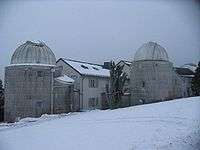Hoher List Observatory
|
Main building | |||||||||
| Organization | Argelander Institute for Astronomy, University of Bonn | ||||||||
|---|---|---|---|---|---|---|---|---|---|
| Code | 017 | ||||||||
| Location | Hoher List, near Daun, Eifel, Germany | ||||||||
| Coordinates | 50°10′N 6°51′E / 50.167°N 6.850°ECoordinates: 50°10′N 6°51′E / 50.167°N 6.850°E | ||||||||
| Altitude | 549 m | ||||||||
| Established | 1954 | ||||||||
| Closed | 2012 | ||||||||
| Website | http://www.astro.uni-bonn.de | ||||||||
| Telescopes | |||||||||
| |||||||||
The Hoher List Observatory (German: Observatorium Hoher List) was an astronomical observatory located about 60 km south of Bonn, Germany, near the town of Daun in the mountain range of the Eifel. The observatory was operated by the Argelander Institute for Astronomy of the University of Bonn until it was closed in 2012.
Until the 1940s, Bonn astronomical observations were carried out mainly from Argelander's old observatory in Bonn itself. With more and more electrical lights in the city, the night sky in town became increasingly brighter, making observations difficult. In search for an alternative location, in 1950, the hill of Hoher List above the village of Schalkenmehren was found to be well suited for astronomical observation. The rural surrounds meant very low sky brightness. It was decided to relocate the Bonn telescopes. The new observatory was inaugurated in 1954, after the 50 cm Schmidt telescope had been installed in the first dome. A major extension in 1964 included the relocation of the Double Refractor, which dates from 1899. The final dome to be erected contains a 1 m Cassegrain telescope, the largest and most modern of the observatory's telescopes. Today, there are six telescopes at the observatory. The Double Refractor aside, there is also the 16 cm Schröder Refractor, which was used for the Cordoba Durchmusterung (the southern extension of the Bonner Durchmusterung).

The observatory was an outstation of the Argelander Institute for Astronomy of the University of Bonn. Many students have obtained their diploma or doctorate, and important scientific work in astrometry and photometry of stars of the Milky Way was carried out. Until its closure in 2012, the Hoher List Observatory lost its scientific significance, as observations from the Eifel have become more difficult. The sky brightness is much increased, and the weather conditions are no match for observatories in Chile or the United States. The Hoher List Observatory delivered the practical parts of student education and provided a laboratory environment to develop astronomical instruments and parts, which may then be deployed on telescopes in, e.g., Spain or Chile.
Since 2007, the 1 m telescope was once more used for current research for the HOLIGRAIL (Hoher List Gravitational Lensing) project.
In 2012, the University of Bonn closed the observatory and no scientific activities are done anymore. The observatory was put under national historic place conservation.
The Förderverein Hoher List, which was formed to support and preserve the Hoher List Observatory, offers guided tours of the observatory, as well as monthly public lectures about astronomy.
External links
| Wikimedia Commons has media related to Hoher List Observatory. |
